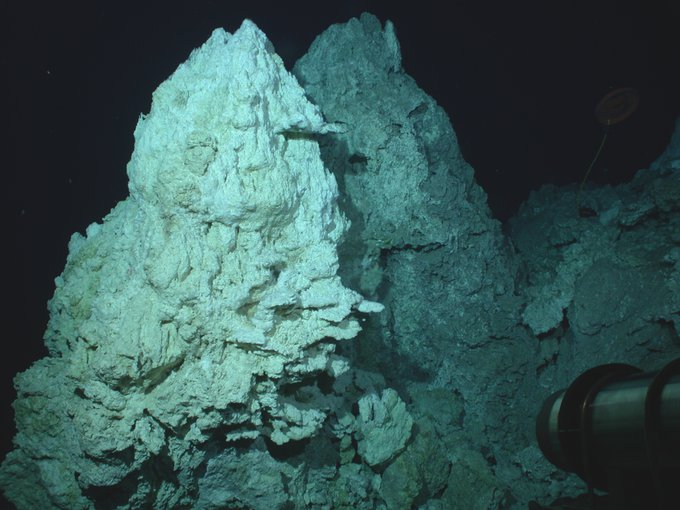
Dec. 3, 2021
Research Highlight
Hydrothermal Vents that Favor Protein Synthesis

A 60 meter (200 feet) tall carbonate chimney in the field of hydrothermal vents known as the Lost CityImage credit: NOAA/University of Washington.
Scientists supported in part by the NASA Astrobiology Program have presented a new perspective on the biochemistry and ecology of hydrothermal vent ecosystems. The finding opens new possibilities for understanding mechanisms that life might use to survive in environments where scorching hot water belches up from underground and mixes with freezing seawater, all in the absence of sunlight.
Recent research shows that hydrothermal systems on Earth that are composed of ultramafic rock (igneous and meta-igneous rock that is low in silica) could be ‘hot spots’ for certain types of microbes. When these rocks undergo serpentinization in hydrothermal systems, they produce more hydrogen than other rock types. This availability of hydrogen ultimately makes the biosynthesis of basic cellular building blocks more favorable. Previous work has shown this to be true for molecules like amino acids and sugars. The new study focused on an organism named Methanocaldococcus jannaschii, and demonstrated that the synthesis of almost all of its proteins were energetically favorable in vent systems with ultramafic rock, particularly at around 185 degrees Fahrenheit (85 Celsius) where the organism grows the fastest. Around different vent systems, protein synthesis is not favorable.
The research could have implications for understanding extremophilic life on Earth as well as the potential for life on other ocean worlds in the Solar System.
The study, “The Release of Energy During Protein Synthesis at Ultramafic-Hosted Submarine Hydrothermal Ecosystems,” was published in the journal JGR Biogeosciences.
https://agupubs.onlinelibrary.wiley.com/doi/10.1029/2021JG006436
A press release from Arizona State University regarding this research is available here.
Related:
Life in the Extreme: Hydrothermal Vents
Network for Ocean Worlds (NOW)